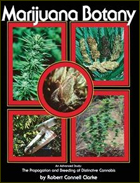
by Robert Connell Clarke
Acclimatization
Much of the breeding effort of North American cultivators is concerned with acclimatizing high-THC strains of equatorial origin to the climate of their growing area while preserving potency. Late-maturing, slow, and irregularly flowering strains like those of Thailand have difficulty maturing in many parts of North America. Even ~:n a greenhouse, it may not be possible to mature plants to their full native potential.
To develop an early-maturing and rapidly flowering strain, a breeder may hybridize as in the previous example. However, if it is important to preserve unique imported genetics, hybridizing may be inadvisable. Alternatively, a pure cross is made between two or more Thai plants that most closely approach the ideal in blooming early. At this point the breeder may ignore many other traits and aim at breeding an earlier-maturing variety of a pure Thai strain. This strain may still mature considerably later than is ideal for the particular location unless selective pressure is exerted. If further crosses are made with several individuals that satisfy other criteria such as high THC content, these may be used to develop another pure Thai strain of high THC content. After these true-breeding lines have been established, a dihybrid pure cross can be made in an attempt to produce an F1 generation containing early maturing, high-THC strains of pure Thai genetics, in other words, an acclimatized bud strain.
Crosses made without a clear goal in mind lead to strains that acclimatize while losing many favorable characteristics. A successful breeder is careful not to overlook a characteristic that may prove useful. It is imperative that original imported Cannabis genetics be preserved intact to protect the species from loss of genetic variety through excessive hybridization. A currently unrecognized gene may be responsible for controlling resistance to a pest or disease, and it may only be possible to breed for this gene by back crossing existing strains to original parental gene pools.
Once pure breeding lines have been established, plant breeders classify and statistically analyze the offspring to determine the patterns of inheritance for that trait. This is the system used by Gregor Mendel to formulate the basic laws of inheritance and aid the modern breeder in predict ing the outcome of crosses
1 – Two pure lines of Cannabis that differ in a particular trait are located.
2 – These two pure-breeding lines are crossed to produce an F1 generation.
3 – The F1 generation is inbred.
4 – The offspring of the F1 and F2 generations are classified with regard to the trait being studied.
5 – The results are analyzed statistically.
6 – The results are compared to known patterns of inheritance so the nature of the genes being selected for can be characterized.

